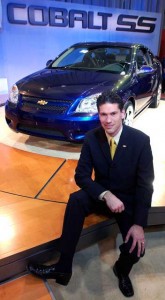
GM Designer Phil Zak, with his 2005 Chevrolet Cobalt, is moving to Hyundai.
General Motors has lost another top designer to a Korean competitor. Hyundai America Technical Center has announced that Phillip Zak has been named chief designer of the Hyundai Design Center in Irvine, California. Zak will be responsible for new vehicle and concept design for Hyundai, officials for the Korean automaker said.
Though design departments have been among the most protected operations in Detroit, the domestic industry’s ongoing problems – and the appeal of the new – threaten to lead to a brain drain from Detroit’s styling studios, industry observers caution.
“Phillip’s strong experience in working across multiple regions and his leadership role on advanced projects was exactly what we were looking for,” said C.K. Park, president, HATCI. “We are thrilled to have Phillip Zak as chief designer for Hyundai and continue the strong momentum of our vehicle designs.”
Zak has more than 20 years of automotive design experience at GM and most recently served as the design director for General Motors Europe where he was responsible for all Opel and Saab exterior production design work and future strategies. Zak started his career at General Motors in 1988 as a designer sketching new vehicle concepts. During his 20-year career at General Motors he held various positions including lead designer, chief designer and design manager.
Throughout his career at General Motors Zak had design responsibility for numerous models including the 2010 Chevrolet Equinox, 2010 GMC Terrain, 2009 Chevrolet Equinox Fuel Cell vehicle, 2005 Chevrolet Cobalt Program and Pontiac G-6 show and production car. Earlier in his tenure he held design responsibility for the 2001 Oldsmobile Bravada, 2000 Oldsmobile Aurora, 1999 Oldsmobile Profile show-car and the 1995 GM Racing Aurora GTS race car design.
“Phillip Zak is an outstanding addition to the design team at HATCI,” said John Krafcik, acting president and chief executive officer, Hyundai Motor America. “We are proud to add such a talented individual to lead the team of dedicated designers at HATCI that will continue to develop innovative vehicles for both the United States and global auto markets.”
Zak holds a Bachelor of Fine Arts from the Cleveland Institute of Art and was a recipient of the Gund C.I.A. Traveling Scholarship.
Korean automakers were often faulted for their stodgy and derivative designs, at least during their early years in the U.S. market. They’ve been stepping up their efforts to develop stand-out products, in recent years. Hyundai, in particular, has been hailed for the edgy styling of recent concept vehicles, such as the HND-4, a prototype plug-in hybrid that strongly hints at the production model set to launch in the Korean market, this coming July.
Early on, Korean makers were fond of using Italian design houses, such as Pininfarina, but most recently they have been recruiting American designers, many of them from GM, to bulk up their design practices. In 2007, Tom Kearns moved to Kia and brought a number of GM designers with him to work on projects such as the latest version of the Kia Soul. Designers working for Hyundai and Kia report they have been given a free hand to create a design language for the Korean brands.
Ed Welburn, GM vice president of design, told TheDetroitBureau.com, recently, that he doesn’t like losing any designer to a competitor. However, he also understands the appeal. Overall, GM’s design staff has been spared the deep cuts that have engulfed other parts of the company as GM struggles to right-size itself in the face a huge cash drain.
But with the maker now set to abandon some of its struggling brands – such as Hummer, Saturn and Saab – and cut back on Pontiac, which will become little more than a specialty niche, that could change. Tellingly, for the first time in many years, GM will not be making job offers to new designers fresh out of school, Welburn said.
Established in 1967, Hyundai Motor Co. has grown into the Hyundai-Kia Automotive Group which was ranked as the world’s fifth-largest automaker in 2008 and includes over two dozen auto-related subsidiaries and affiliates with 75,000 employees worldwide.
